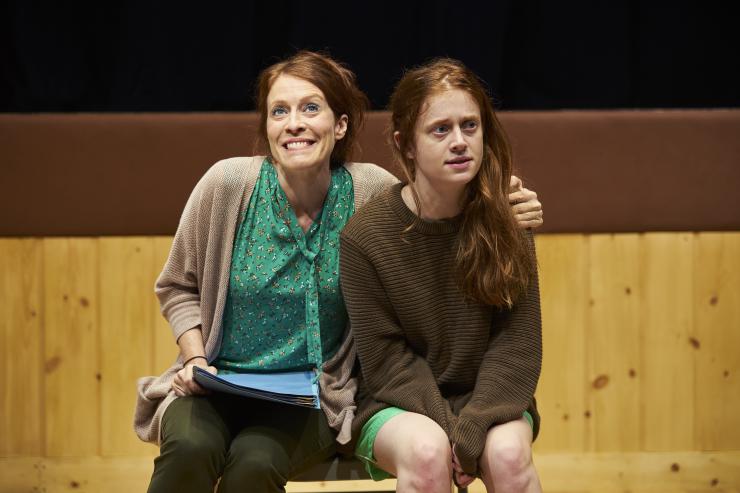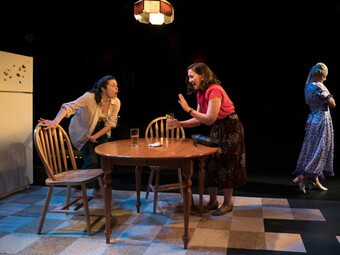Sabine Women, Satire, and What Is Truly “Daring?”
In The New York Times critic Jesse Green’s review of Michael Yates Crowley’s The Rape of the Sabine Women, by Grace B. Matthias, which recently ran at The Duke on 42nd Street, he writes that the play “dares itself to be a satire.” The play, produced by The Playwrights Realm, centers around the titular character of Grace B. Matthias (B doesn’t stand for anything, Grace just likes the letter). Fifteen-year-old Grace’s alleged assault by the high school’s football star drastically alters her life, her town’s local news, and the archetype-laden culture of her school and community.
When the play begins, Grace is knee-deep in the multifaceted aftermath of experiencing and reporting a sexual assault. Her mother works odd, long hours for what appears to be little money; her father is out of the picture. Her one school friend is an over-the-top cheerleader who will eagerly root for (and party with) the team even after what Grace has gone through.

Throughout the play, we go back and forth in time as trials progress and memories are recounted. Grace’s guidance counselor discourages her from being “emotional” and questions whether or not she is remembering details correctly. Her lawyer tells her to stick to the “outline” he provided, one that emphasizes “how damaged” she is and nothing else. Meanwhile, Grace has dreams of being a fireman, complicated memories of her alleged rapist Jeff, and a desire to learn of the actual Sabine women, misrepresented in history books penned by men.
Satirical art tackling edgy subjects is everywhere…It’s easy to see why: At its core, satire pokes fun at people and viewpoints in order to expose them as corrupt.
Jesse Green wasn’t the only one to express surprise at a play about sexual assault being satirical, humorous, and at times absurd. An article in TDF Stages, included in the play’s press packet, calls Sabine Women “gutsy,” stating “You don’t expect a play dealing with rape to contain much humor.”
However, an artwork about sensitive issues attempting to be humorous or satirical is not daring, nor is it rare. Satirical art tackling edgy subjects is everywhere, from the niches of the internet to network TV. It’s easy to see why: At its core, satire pokes fun at people and viewpoints in order to expose them as corrupt. It is a highly noble genre that has found many powerful uses throughout history. Despite (or perhaps because of) this, it has become wildly common for creators to take cheap shots under the guise of “satire,” because it’s fine if you obviously mean the opposite of what you are saying, it’s just comedy, and PC culture has totally gone too far.
“Traditionally, satire has comforted the afflicted while afflicting the comfortable. Satire punches up, against authority of all kinds, the little guy against the powerful,” notes satirist and cartoonist Garry Trudeau in a speech reprinted in The Atlantic. “Ridiculing the non-privileged is almost never funny—it’s just mean.”
In a recent essay for The Outline, Jeff Ihaza takes on one of the most notable satirical shows of our time: South Park. Dubbing it “a case study in what happens when woke white dudes keep making art for other woke white dudes” that “rarely strays from #alllivesmatter territory,” he argues that instead of actually subverting the establishment, it makes viewers feel like they are while continuing to leave the marginalized behind.
Theatre is also not immune to this. Popular, Tony Award-winning Broadway musicals such as Avenue Q and The Book of Mormon have received wide acclaim for their skewering songs and edgy content that, well, still manage to be digestible and pleasant for those that can fork over $100 or more per ticket. Spend two hours chortling about how “Everyone’s A Little Bit Racist,” then go home and continue life as usual.
Avenue Q’s song “Everyone’s A Little Bit Racist” is a clear example of the satire Ihaza argues empowers the wrong people. There have even been entire academic papers written on how the song erases systemic causes of racism in America in lieu of the narrative that prejudice is engrained in everyone and it’s fine as long as you can admit it and laugh about it. The song puts statements like “the whites have all the power” (said by the show’s Japanese character, Christmas Eve) in the same category as “black jokes.” Intentional or not, placing all race-related remarks on the same plane treads dangerously close to perpetuating the (still popular) idea that “reverse racism” should be judged the same as actual racism, which ultimately does nothing to “comfort the afflicted while afflicting the comfortable.”
In Mormon’s case, much was said about how “offensive” this show was to the Mormon religion and how the (predominantly white, well-educated) Mormons would react to such content, while far less was said about the portrayal of Ugandans as AIDS-riddled heretics in an age when the “white savior” narrative still populates countless Instagram feeds. Sure, Sabine Women’s inclusion of two “male experts on rape” may be a bit heavy-handed, but the male population could bear to shoulder a little more weight.
As soon as we finish laughing about a phrase as absurd as ‘legitimate rape,’ we recall that an actual elected official with more power to enact change in this country than you or I has actually uttered such a thing.
The world of Sabine Women is that of binaries, or “opposites,” as the play would put it. A woman cannot be a fireman because they’re called firemen, not firepeople. According to the town doctor, violence always “leaves a mark” on a body and anything that does not, is not. However, it does not take sides when it comes to the binary of satirical versus genuine, and that is precisely why it succeeds. If the absurd, over-the-top tone was the only thing present onstage, it would feel disrespectful to real issues. If the entire play was dramatic and emotional, it would risk being sensational or even exploitative. As soon as we finish laughing about a phrase as absurd as “legitimate rape,” we recall that an actual elected official with more power to enact change in this country than you or I has actually uttered such a thing.
This becomes crystal clear near the end of the play, after the boys escape indictment, Grace is painted as a troubled liar, and her rapist slash object of affection Jeff dies in a car crash. Grace’s cheerleader friend Monica chastises her at Jeff’s funeral, saying “You act like you’re the only one who got R.A.P.E.’d in this whole town! Newsflash Grace: you’re not that special.” When Grace wonders why Monica hadn’t mentioned this earlier, Monica simply replies, “Because look what talking gets you.”

Michael Yates Crowley, along with director Tyne Rafaeli, has created a world in which the systems in American society are working as they are designed to. In an ideal world, everything on the television news is accurate, history books tell the whole story, marriage means happiness, jury decisions reflect the truth. But because we do not live in an ideal world, particularly not those of us that belong to marginalized groups, these systems working successfully can swiftly lead to injustice and the shattering of lives. And because we do not live in an ideal world, we must ensure those who are comfortable realize this over and over until something is to be done about it.
Green’s review argues that Grace is the only “living human” in the play, implying the absurd treatment of the rest of the characters renders them unbelievable and one-note. But all the characters aside from Grace (the guidance counselor, the lawyer, the news anchor, the cheerleader, the football stars, etc.) all easily fit into Trudeau’s characterization of “the comfortable,” making them ripe for ridicule, although Green has a point about the blatantly closeted jock trope being a bit tired. A greasy-haired teen outcast and sexual assault survivor having notably more agency than her privileged associates feels far more like a radical achievement than a writing flaw. As Crowley wrote in the play’s program, “A good story, well told, can extend the space in which we are free.”
The Rape of the Sabine Women, By Grace B. Matthias is a play about sexual assault written by a man and a satire, yes, but it is not daring or edgy because of those things. It is daring because it resists so many of the traps it could easily fall into. On second thought, perhaps it is daring because it is a satire. A genuine satire, one that actually makes those in power look absurd, and lets those in pain literally have the last word.









Comments
The article is just the start of the conversation—we want to know what you think about this subject, too! HowlRound is a space for knowledge-sharing, and we welcome spirited, thoughtful, and on-topic dialogue. Find our full comments policy here
Thanks so much for this review! I'm curious as to what responses other people have had to the play, and whether it hit the right notes among a broad segment of audiences and communities. I ask because of the current controversy at the Marin Theater Company, which has had a very negative response to their show "Thomas and Sally" (yes, Jefferson and Hemmings) from many people, including a large number of women of color. https://www.facebook.com/Ma....